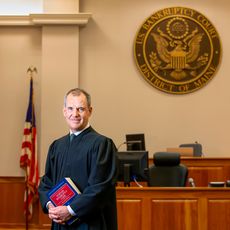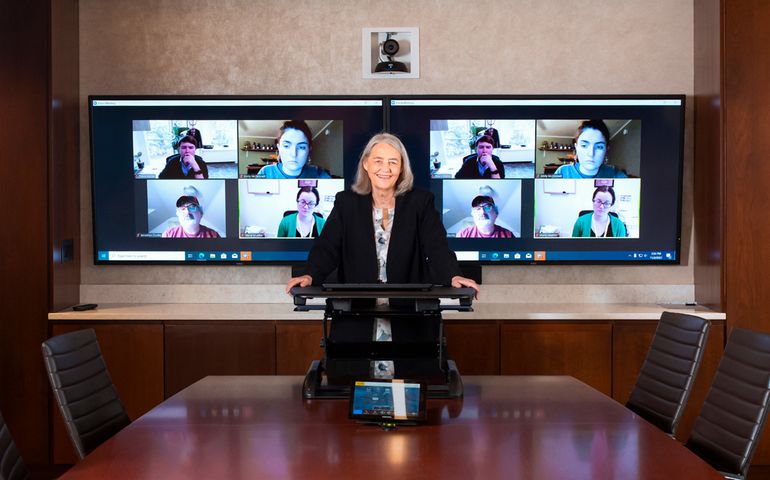
Trial by Zoom: Maine jurists navigate new reality of remote justice
 Photo / Tim greenway
When on Zoom, Verrill litigation partner Martha Gaythwaite, who chairs the law firm’s litigation and trial practice, likes to argue cases at a podium to simulate the courtroom experience.
Photo / Tim greenway
When on Zoom, Verrill litigation partner Martha Gaythwaite, who chairs the law firm’s litigation and trial practice, likes to argue cases at a podium to simulate the courtroom experience.
Above Mister Bagel on Congress Street in Portland, U.S. Bankruptcy Court for the District of Maine is in session as Chief Judge Peter Cary runs through 10 cases in 50 minutes.
While the courtroom might normally be packed on a so-called “cattle-call day,” today it’s mostly empty save for Cary, two law clerks and one lawyer involved in several cases. Others join by phone, including the Brunswick-based trustee for all Chapter 13 cases involving repayment by individuals with regular income and debts below $1.7 million.
During the proceedings, Cary checks two computer screens from the bench — one for research and one with the day’s docket. Owing to technology in place long before COVID, the court’s business never stopped, even when the court was closed to the public, except for emergencies, for more than a year.
“The bankruptcy court was wonderfully equipped to be remote ages ago, and it was quite literally a flip of the switch in March 2020 when we went fully from a face-to-face court system to being remote overnight,” he says. “Everybody had the capacity to work from home and to conduct full court business from home.” While Cary has been coming to court all along, he also appreciates the convenience of using Zoom to help parties settle cases that now take place on a computer screen rather than in his chambers.
“The great thing about Zoom is that you can create different breakout rooms, and I can migrate back and forth,” Cary says. “I explored a new model for doing these mediations over a matter of weeks, and we’ve had a success rate in the high 80th percentile. It’s been miraculous.”

From Maine’s tech-savvy, specialized federal bankruptcy courts to underfunded, short-staffed state courts with an ever-growing case backlog, remote justice is a brave new world accelerated by the pandemic that many attorneys and judges are still learning to navigate.
“At first it was pretty tricky, because the courts and the law in general is a pretty conservative field, so there’s a lot of resistance to any sort of change,” says Ryan Rutledge, an attorney with Mills, Shay, Lexier & Talbot PA in Skowhegan. “COVID forced us to do things we thought about doing for a while but were never encouraged to or supported by the judiciary.”
Rutledge, a general practitioner whose cases range from court-appointed criminal defense work to real estate and family law, says that while the remote option is convenient for things like five-minute hearings that would normally require a commute to and from the courthouse, the inability to communicate directly with an incarcerated client testifying via video is a drawback. He’s also found that in family mediations, people act differently when they’re on the phone versus appearing on a screen or in-person.
Reflecting on COVID’s learning curve for lawyers, he says, “It’s called the practice of law for a reason. You’re constantly having to adapt to whatever is going outside the courtroom.”
The move to remote justice extends well beyond Maine and includes the U.S. Supreme Court, which made history in May 2020 with its first-ever telephonic oral arguments that were livestreamed on news sites and broadcast on C-SPAN with only minor hiccups.
Other tribunals have had bigger stumbles, like the lawyer famously trapped in a Zoom kitten filter in a virtual hearing in Texas’s 394th Judicial District Court, declaring, “I am not a cat.”

Feline funniness aside, Zoom and other remote platforms have become the norm in state and federal jurisdictions nationwide — and look here to stay.
To help state courts in the transition, the national Conference of Chief Justices and Conference of State Court Administrators published guiding principles last year for post-pandemic court technology and called on courts to seize an “extraordinary opportunity” to deliver better justice.
In Maine, telephone or video remains the preferred format for most court proceedings in all trial courts as of early October under guidelines published by the Maine Judicial Branch.
Trials taking place via video have meant a big adjustment for litigators, following the initial shock of courthouses shutting down early in the pandemic.
“When COVID hit and everything went on hold, it was the first time since I was a baby lawyer I didn’t have a trial,” recalls Verrill’s Martha Gaythwaite, a partner who leads the firm’s litigation and trial group. “I usually have several trials a year, and all of a sudden, it was like somebody shut the lights off, and we were scrambling to figure out how to deal with the new reality.”
Her solution when on Zoom was to simulate the courtroom experience while standing at a podium in an office conference room. In one remote federal patent dispute case, the judge in Massachusetts presided from her son’s bedroom clad in official garb backed by the judicial seal though in some instances the son’s Disney wallpaper peeked through. Witnesses testified remotely from around the world, including a client of Gaythwaite’s in Macau, China.
“It was a fascinating experience, and one that we would never have been able to do even a few years ago,” she says. “I’m still pretty old school and would have preferred to have done it in person. Having said that, the case got resolved through a trial.”
Bernstein Shur’s James Monteleone, a litigator with cases in state and federal courts, would also like to be in court more often but has come to appreciate the ability to be remote especially for non-evidentiary proceedings.
But he also reports some “strange hiccups” along the way, like a short-lived requirement for attorneys to use virtual courtroom backgrounds on Zoom in cases before the Maine Law Court, and ongoing hitches with electronic filing that state courts are still struggling figure out.
Kelly McDonald of Murray Plumb & Murray, who chairs the Portland firm’s bankruptcy practice, has also seen some unusual things on Zoom, like when a third-party witness was seen reaching for a beer.
“I was like, ‘OK, that’s a first,’ but at least he had pants on,” he says.
McDonald, who worked from home for 14 months, says Zoom has performed well for depositions and mediations and even a bankruptcy case in Massachusetts that was completely remote. Putting on his hat as Maine State Bar Association president, McDonald says the group plans to shift all its meetings to Zoom and has been working closely with the judicial branch throughout the pandemic.
Telephone and video hearings have also been used throughout the pandemic by U.S. immigration courts, with a nationwide backlog of close to 1.57 million active cases as of September.
While there are guidelines in place for remote hearings via WebEx, video teleconferencing and other technologies which were last updated in November 2020, the American Immigration Lawyers Association has expressed concern about the growing and unilateral use of virtual hearings without a public health justification. The group also warns that virtual hearings can adversely affect respondents’ ability to access due process, citing cases where judges do not adjourn hearings when technology fails.
To ensure fairness, the organization recommends limiting the use of virtual hearings to procedural matters, making most virtual hearings available to the public, and that the Executive Office for Immigration Review use in-person interpreters whenever possible for in-person hearings. Since there is no immigration court in Maine, Boston is the nearest venue. While that’s been a huge time-saver for Maine cases during the pandemic, the remote option gets mixed reviews from some immigration attorneys.
“We sometimes make a round trip for a five-minute appearance, so I really welcome the use of video hearings in those instances, but I have very real concerns about the use of video hearings for substantive immigration hearings concerning the merits of a case,” says Melissa Brennan, a supervising attorney at the Immigrant Legal Advocacy Project, a Portland-based nonprofit that defends non-citizens against deportation.
“In all of these types of cases, it is concerning that a video hearing may make it difficult for a judge to assess a person’s credibility or to establish a personal connection with the respondent,” she says, also pointing to remote foreign-language interpretation as another area of difficulty.
“Since many of our clients don’t speak English, in a typical in-person court hearing you would have simultaneous interpretation,” she says. “When doing that over video, I feel concerned about the accuracy of the interpretation because the interpreter is hearing the client through a computer and connections are not always ideal.”
Echoing those concerns, immigration attorney Aga Asbury of Portland’s FordMurray says she has not participated in any remote hearings and that she began accompanying clients to interviews as soon as services for green cards and naturalizations were reopened.
“I know that some immigration attorneys chose to call in, but I like to interact with interviewing officers in person,” she says.
At Pine Tree Legal Assistance, which provides free legal civil aid in Maine, staff attorney and intake director Maureen Boston sees pluses and minuses of remote proceedings both for litigants representing themselves and those with legal counsel.
Her main concern: “The lack of statewide consistent procedures around what is being held remotely and what is in-person, combined with court notices that are outdated or contain incorrect information, have created challenges for litigants to know how they should appear in court.”
More than 20 student attorneys in the clinical program at the University of Maine School of Law have also powered through virtual hearings, dispositional conferences and case management and court dates where there wasn’t an issue being litigated, reports Christopher Northrop, a professor.
But he says that not being in the same room as the clients during trials posed communication barriers, with lawyers and clients texting each other during direct- and cross-examination.
“Everything during the trial was just more difficult,” he says. “Litigation is developed as an in-person thing, and it was hard for the students, hard for the judges, hard for everybody to try to get through a trial, and to get through any contested hearing, when Zoom was weak.”
Despite those hurdles, Maine Law Dean Leigh Saufley was impressed with the students, saying, “They continued to represent people throughout the pandemic, and they just did a terrific job.”
Reflecting on her time on the bench, Saufley, a former chief justice of the Maine Supreme Judicial Court, noted that video procedures and conference calls pre-date the pandemic particularly for arraignments, along with phone conferences and hearings in preliminary family matters.
As she observed the shift to remote work during the pandemic, Saufley was struck by how courts worked to ensure access to justice, saying, “I think the Maine courts did as good a job as anyone in the country in making sure the cases they could reach did get reached during that time.”













0 Comments